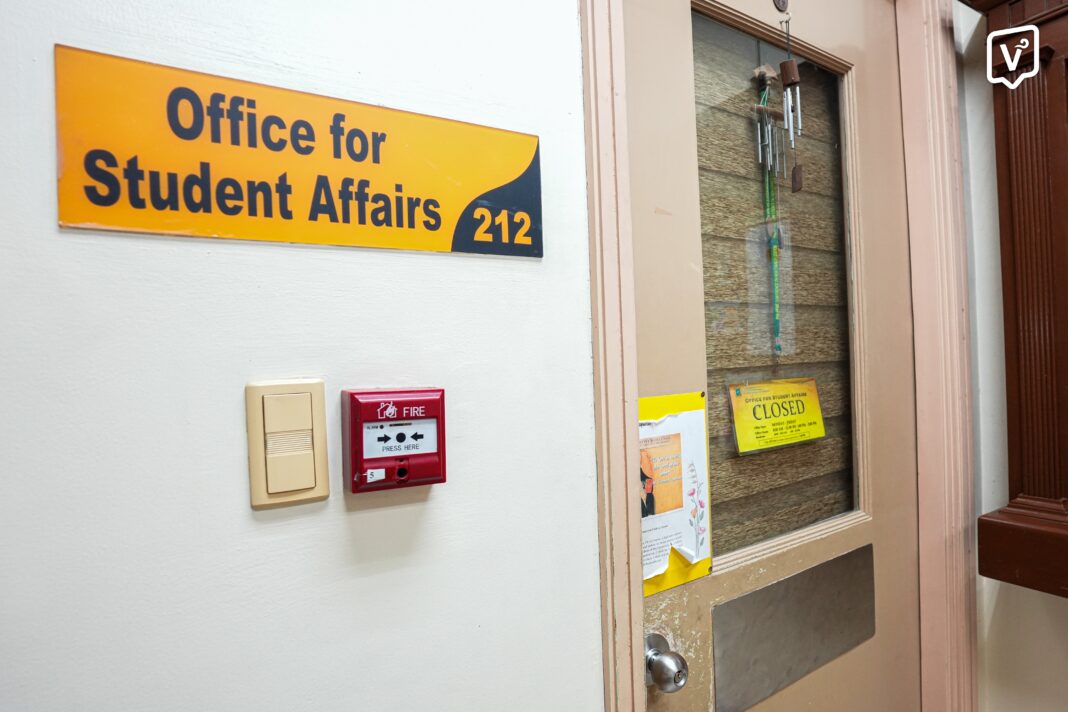 The backward-thinking Office for Student Affairs (OSA) has caused embarrassment for the University after its ludicrous decision to censor a post by TomasinoWeb showing College of Information and Computing Sciences (CICS) students entering a 7-Eleven store on campus.
The backward-thinking Office for Student Affairs (OSA) has caused embarrassment for the University after its ludicrous decision to censor a post by TomasinoWeb showing College of Information and Computing Sciences (CICS) students entering a 7-Eleven store on campus.
The OSA’s attempt to quell potential embarrassment backfired spectacularly. By trying to suppress the post, the OSA inadvertently thrust itself and the University into the spotlight of public scrutiny.
Students, alumni, journalists, and journalist groups have united in condemnation of the OSA’s handling of the situation, which even resulted in the resignation of its adviser, who is an instructor for UST’s journalism program, the oldest surviving journalism program in the country, and a desk editor for the reputable Philippine Star.
Indeed, one might question the logic behind appointing a journalist as an adviser for a media organization if the OSA hinders it from upholding basic journalistic principles. Despite not being a traditional publication, TomasinoWeb functions as a media organization engaging in digital journalism.
Ordering the organization not only to take down the harmless photo but also to issue a public apology was unnecessary. In a curious turn of events, the OSA found itself at the center of the very public ridicule it sought to avoid. Its heavy-handed response to a simple post by an organization has revealed its true nature: a blight on the reputation of UST and a betrayal of the principle of synodality.
The poor Central Student Council (CSC) could not even issue an official statement; instead, its Executive Board members resorted to releasing a joint statement on their personal Twitter accounts, likely because the CSC is under OSA leadership.
The CSC officers said OSA’s “hasty act of censorship” against TomasinoWeb was not an isolated incident but the latest in “a continuous pattern of repression faced by student organizations and formations within the University.”
“It reflects the dysfunctional and restrictive process within the institution and it shows the system for what it truly is—one that actively limits and controls the Thomasians’ rights to freedom of expression and right to academic freedom,” their statement read. “Under the guise of aligning with the institution’s standards and principles, students, student organizations, and even student councils are unable to truly express and represent the plights and grievances of the student body.”
In the first place, what is the issue with being joked about uniforms resembling those of a convenience store? How does that lead to ridicule for UST? There are several jokes about UST uniforms: the CICS Type B uniforms being likened to 7-Eleven uniforms; the Type A uniform for women in the Faculty of Arts and Letters being compared to grade school uniforms; and the Type B uniforms of College of Architecture students being said to resemble the maroon of the University of the Philippines. These jokes have turned into light-hearted banter, rather than the public ridicule that the OSA subjected itself and the University to.
In a statement, the National Union of Journalists of the Philippines said OSA’s move exposed the University’s elitism, noting that “any imposed takedown, especially over an imagined slight and not because of a factual or ethical lapse, erodes press freedom and the independence of the press.”
The OSA’s restrictive actions also seem to run counter to the principles of synodality, which emphasize a more inclusive and consultative approach within the Church. Given its position as the primary office for student affairs in the Pontifical and Catholic UST, the OSA should be receptive to criticism and open to growth.
During the 10th Philippine Conference on the New Evangelization held at UST last month, Cardinal Mario Grech, secretary general of the Synod of Bishops, said tensions could be “generative of something new.”
“If there are tensions, that means that the people of God are interacting,” he said. “Even disagreement can help in the dialogue, can help all of us to deepen our knowledge of the truth.”
The issue should serve as a call to action for more courageous student leaders. Seven candidates have been named official candidates for this year’s student polls, and it is hoped that they will be able to address the longstanding divide between students and administrators that has plagued campus politics and led to dwindling interest in it in recent years.
If the CSC is reduced to being puppets of the OSA, then the elections will continue to be meaningless. More and more, the CSC is being relegated to mere “event organizer” roles, instead of being the true voices of the student body.
The PR nightmare caused by the OSA should serve as a lesson to many: to itself, that it should cease its overreaction to campus journalism and overstepping on organizations; to the CSC aspirants, that they have a long road ahead in fighting for students’ rights; and to the Thomasian student body, that now more than ever they should actively participate in the discourse at UST.
















